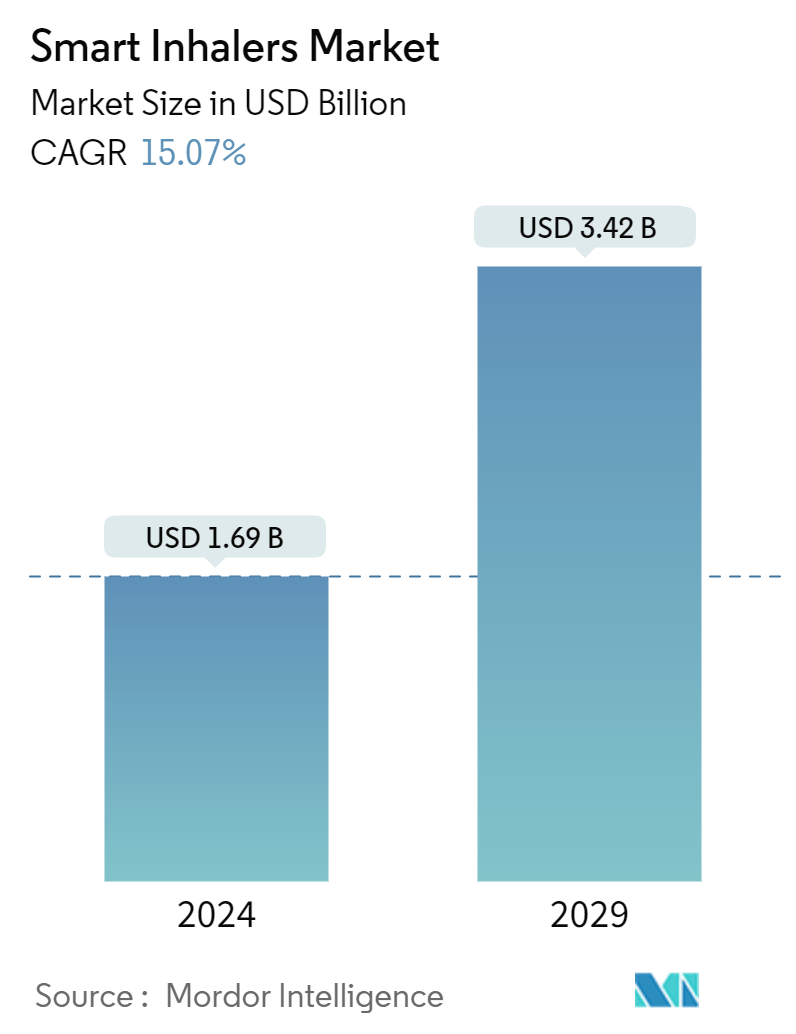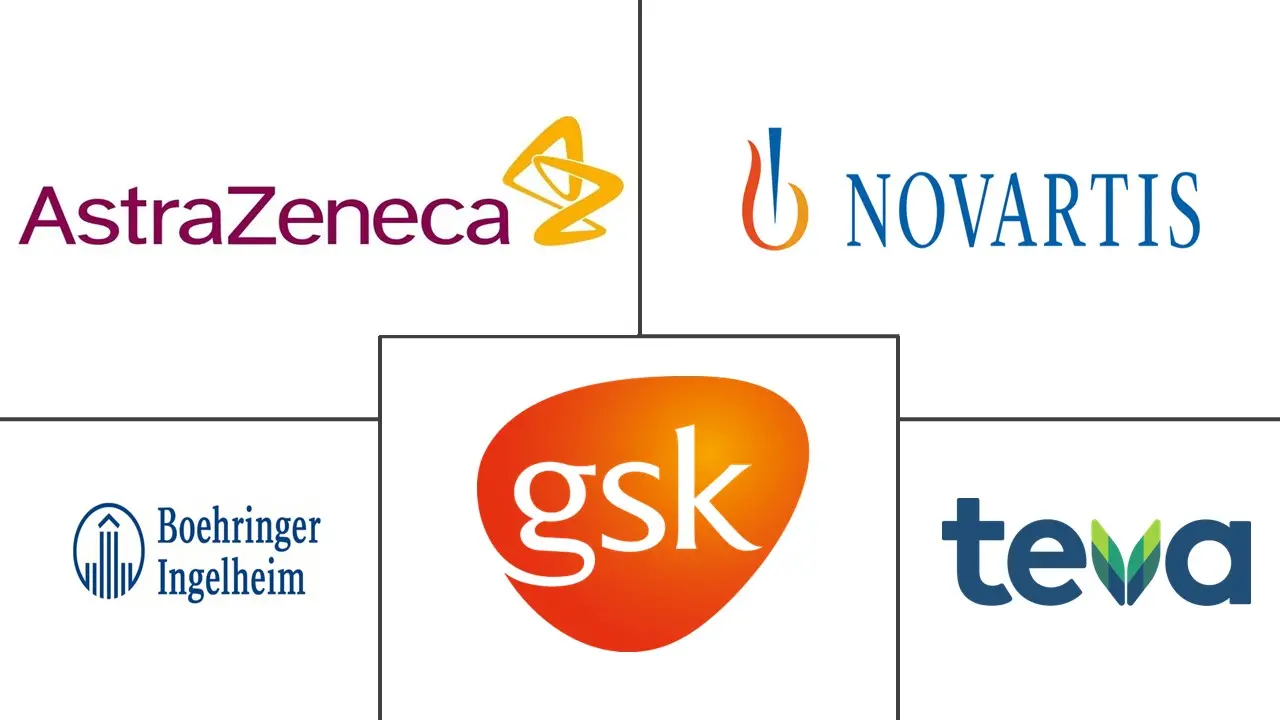Market Size of Smart Inhalers Industry

| Study Period | 2021 - 2029 |
| Market Size (2024) | USD 1.69 Billion |
| Market Size (2029) | USD 3.42 Billion |
| CAGR (2024 - 2029) | 15.07 % |
| Fastest Growing Market | Asia Pacific |
| Largest Market | North America |
Major Players
*Disclaimer: Major Players sorted in no particular order |
Smart Inhalers Market Analysis
The Smart Inhalers Market size is estimated at USD 1.69 billion in 2024, and is expected to reach USD 3.42 billion by 2029, growing at a CAGR of 15.07% during the forecast period (2024-2029).
The pandemic accelerated the adoption of telehealth and remote patient monitoring. The surge in telemedicine during the pandemic amplified the significance of smart inhalers, facilitating remote patient monitoring and data collection. The increased demand for virtual healthcare services drove the adoption of remote solutions, aligning with the evolving landscape of healthcare delivery. With the increased focus on respiratory health during the pandemic, patients and healthcare providers became more conscious of the importance of adherence to inhaler regimens. Smart inhalers with reminder features helped patients stay on track. Smart inhalers helped reduce the burden on healthcare systems by enabling efficient monitoring and management of respiratory conditions remotely, freeing up resources to combat the pandemic. The overall effect was likely an increased awareness and adoption of smart inhaler technologies, especially for the management of respiratory conditions.
Therefore, the pandemic turned out to be a leading factor in the growth of the smart inhalers market. The industry is poised for significant growth, driven by an escalating prevalence of respiratory conditions, a growing emphasis on proactive and personalized healthcare, advancements in sensor technologies, and the increasing integration of digital health solutions into mainstream medical practices.
Furthermore, increasing air pollution, smoking, and the aging population contribute to a growing number of individuals affected by chronic respiratory disorders. A recent estimation based on data from 194 countries, published in the Global Initiative for Asthma Reports, 2020, concluded that each year, 4.0 million new cases of pediatric asthma might be attributable to NO2 pollution, accounting for 13% of global incidence. This contribution exceeded 20% of new asthma cases. The European analysis subset reported in the same paper estimated that 17% of the burden in Western Europe, 14% in Central Europe, and 17% in Eastern Europe was attributable to NO2. Patients with these diseases require effective management of their conditions to control symptoms and prevent exacerbations. Inhalers are a primary means of treatment for these conditions.
In addition, poor medication adherence is a significant issue in the management of chronic respiratory disorders. According to a study published by the National Library of Medicine in 2022, poor medication adherence and incorrect inhaler use lead to suboptimal asthma control. Medication adherence varies from 13% to 52% across the world. Several factors, such as illness perceptions, medication beliefs, forgetfulness, difficulty understanding inhaler techniques, attitude toward the illness, and self-efficacy, contribute to poor medication adherence. Many patients struggle to adhere to prescribed inhaler regimens, leading to suboptimal disease control. Smart inhalers offer features like reminders, dose tracking, and data sharing with healthcare providers. These features have been proven to significantly improve patient adherence to inhaler regimens. A research study conducted at the Groningen Research Institute for Asthma and COPD (GRIAC) in the Netherlands concluded that smart inhalers help healthcare professionals by providing guided self-management. It was also stated that several studies have found that electronic inhaler reminders significantly increase medication adherence compared to standard care. This leads to a reduction in hospitalizations, emergency room visits, and associated healthcare costs, benefiting both patients and healthcare systems.
Teva’s ProAir Digihaler is the first digital inhaler with built-in sensors, which allows for remote monitoring and adjustment of treatment plans. This became especially important during the COVID-19 pandemic and has since become a standard of care. Smart inhalers empower patients by providing them with tools to manage their condition actively. The ability to track their inhaler usage and symptoms enhances patient engagement in their own care.
Therefore, the increasing demand for smart inhalers has driven innovation in the field, and more companies are investing in research and development, resulting in a wider range of smart inhaler options. However, challenges such as the availability of traditional inhalers as a substitute, stringent regulatory requirements, and compliance standards could impede innovation and rapid expansion of the smart inhalers market. In addition, the potential financial burden on patients, stemming from the higher costs associated with these advanced devices, may pose a restraint, limiting their accessibility, particularly in regions with limited healthcare resources.
Smart Inhalers Industry Segmentation
As per the scope of the report, the smart inhalers market involves technologically advanced inhalation devices designed to monitor and enhance the treatment of respiratory conditions. These devices typically integrate sensors, connectivity features, and data analytics to provide real-time feedback, promote medication adherence, and enable personalized management of respiratory diseases such as asthma and COPD.
The smart inhalers market is segmented by product type, indication, distribution channel, and geography. By product type, the market is segmented into dry powder inhalers (DPI) and metered dosage inhalers (MDI)). By indication, the market is segmented into asthma, chronic obstructive pulmonary disorders (COPD), and others. By distribution channel, the market is segmented into hospital pharmacies, retail pharmacies, and e-commerce. By geography, the market is segmented into North America, Europe, Asia-Pacific, the Middle East and Africa, and South America. The report offers market sizes and forecasts in terms of value (USD) for the above segments.
| By Product Type | |
| Dry Powder Inhalers (DPI) | |
| Metered Dosage Inhalers (MDI) |
| By Indication | |
| Asthma | |
| Chronic Obstructive Pulmonary Disorders (COPD) | |
| Others |
| By Distribution Channel | |
| Hospital Pharmacies | |
| Retail Pharmacies | |
| E-commerce |
| Geography | ||||||||
| ||||||||
| ||||||||
| ||||||||
| ||||||||
|
Smart Inhalers Market Size Summary
The smart inhalers market is poised for substantial growth, driven by the increasing prevalence of respiratory conditions and the rising emphasis on proactive, personalized healthcare. The COVID-19 pandemic significantly accelerated the adoption of smart inhalers, as these devices facilitated remote patient monitoring and data collection, aligning with the surge in telehealth services. The heightened awareness of respiratory health during the pandemic underscored the importance of adherence to inhaler regimens, with smart inhalers offering features like reminders and dose tracking to enhance patient compliance. This shift towards digital health solutions is further supported by advancements in sensor technologies and the integration of these devices into mainstream medical practices, which are expected to propel the market forward.
The market landscape is characterized by the dominance of metered-dose inhalers (MDIs) with smart features, which are gaining traction due to their familiarity and ease of use. Technological advancements, such as inhaler analytics and mobile app integration, are enhancing the effectiveness of these devices, making them attractive options for patients managing chronic respiratory disorders. North America is anticipated to lead the market, supported by a robust healthcare infrastructure and a high prevalence of respiratory diseases. The region's focus on developing advanced smart inhaler technologies, coupled with regulatory support, is driving innovation and market expansion. The competitive landscape is fragmented, with key players like Teva Pharmaceutical Industries, AstraZeneca, and GlaxoSmithKline actively contributing to the market's growth through product launches and strategic collaborations.
Smart Inhalers Market Size - Table of Contents
-
1. MARKET DYNAMICS
-
1.1 Market Overview
-
1.2 Market Drivers
-
1.2.1 Growing Prevalence of Respiratory Diseases
-
1.2.2 Technological Advancements Owing to Telehealth and Remote Patient Monitoring
-
1.2.3 Improved Medication Adherence
-
-
1.3 Market Restraints
-
1.3.1 Availability of Traditional Inhalers as a Substitute
-
1.3.2 High Cost Associated with These Advanced Devices
-
-
1.4 Porter's Five Forces Analysis
-
1.4.1 Threat of New Entrants
-
1.4.2 Bargaining Power of Buyers/Consumers
-
1.4.3 Bargaining Power of Suppliers
-
1.4.4 Threat of Substitute Products
-
1.4.5 Intensity of Competitive Rivalry
-
-
-
2. MARKET SEGMENTATION (Market Size by Value - USD)
-
2.1 By Product Type
-
2.1.1 Dry Powder Inhalers (DPI)
-
2.1.2 Metered Dosage Inhalers (MDI)
-
-
2.2 By Indication
-
2.2.1 Asthma
-
2.2.2 Chronic Obstructive Pulmonary Disorders (COPD)
-
2.2.3 Others
-
-
2.3 By Distribution Channel
-
2.3.1 Hospital Pharmacies
-
2.3.2 Retail Pharmacies
-
2.3.3 E-commerce
-
-
2.4 Geography
-
2.4.1 North America
-
2.4.1.1 United States
-
2.4.1.2 Canada
-
2.4.1.3 Mexico
-
-
2.4.2 Europe
-
2.4.2.1 Germany
-
2.4.2.2 United Kingdom
-
2.4.2.3 France
-
2.4.2.4 Italy
-
2.4.2.5 Spain
-
2.4.2.6 Rest of Europe
-
-
2.4.3 Asia-Pacific
-
2.4.3.1 China
-
2.4.3.2 Japan
-
2.4.3.3 India
-
2.4.3.4 Australia
-
2.4.3.5 South Korea
-
2.4.3.6 Rest of Asia-Pacific
-
-
2.4.4 Middle East and Africa
-
2.4.4.1 GCC
-
2.4.4.2 South Africa
-
2.4.4.3 Rest of Middle East and Africa
-
-
2.4.5 South America
-
2.4.5.1 Brazil
-
2.4.5.2 Argentina
-
2.4.5.3 Rest of South America
-
-
-
Smart Inhalers Market Size FAQs
How big is the Smart Inhalers Market?
The Smart Inhalers Market size is expected to reach USD 1.69 billion in 2024 and grow at a CAGR of 15.07% to reach USD 3.42 billion by 2029.
What is the current Smart Inhalers Market size?
In 2024, the Smart Inhalers Market size is expected to reach USD 1.69 billion.

